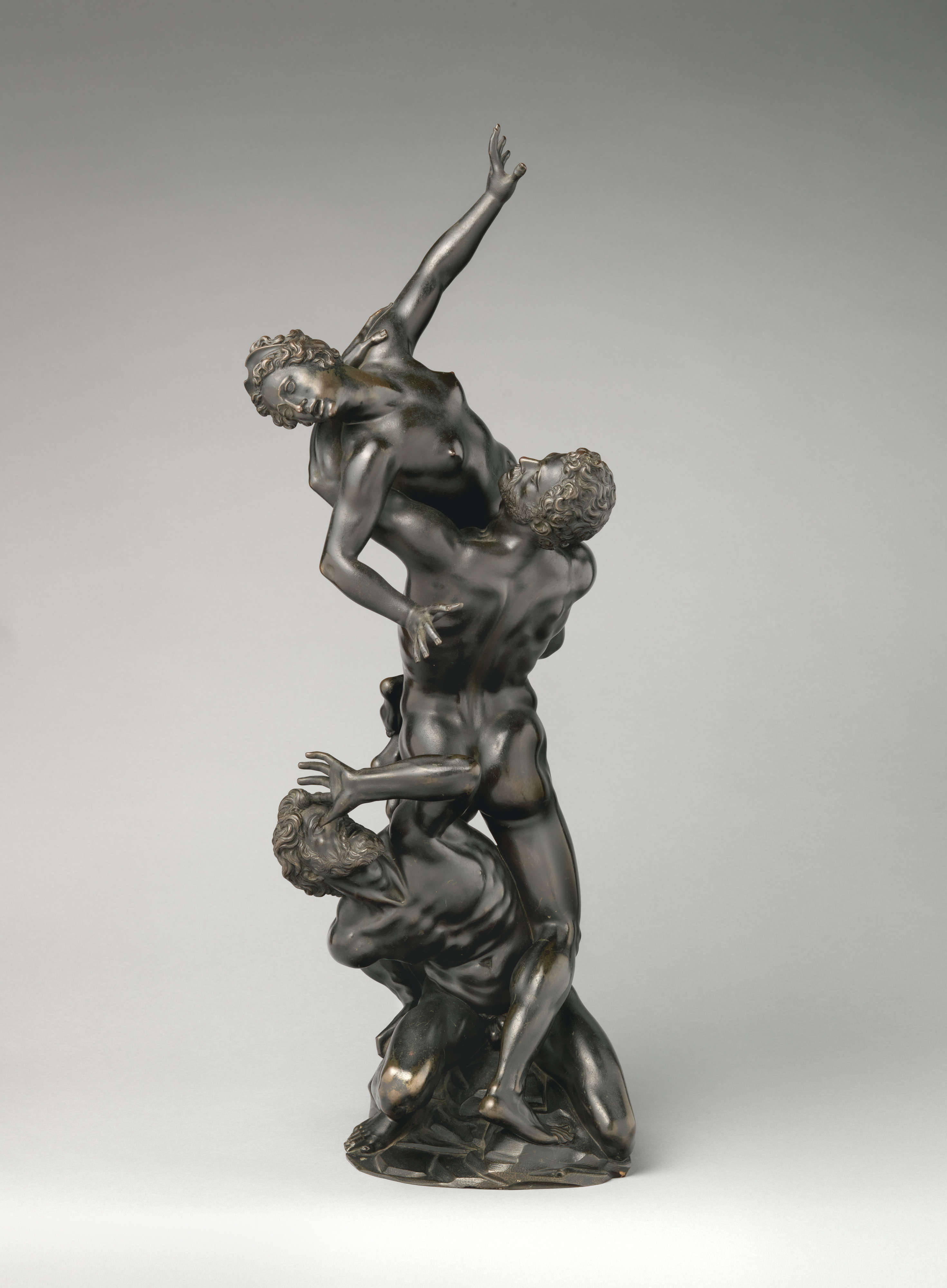Abduction of a Sabine
After a model by Giambologna Netherlandish
Not on view
This bronze group is a reduction of Giambologna’s marble Abduction of a Sabine, installed in the Loggia dei Lanzi in Piazza della Signoria, Florence, in August 1582 and officially unveiled in January 1583. The bronze entered The Met in 1970 as a gift from Irwin Untermyer, who had acquired it in 1969 for the sum of $16,000.[1] James David Draper published it in 1977 as “after Giovanni Bologna” and compared it favorably to other, better reductions of the marble. In reality, our Abduction deviates in significant respects from the large sculpture. For example, it features a different rocky base, the addition of an elaborate diadem in the woman’s hair, and the eyes of all three figures are incised with pupils and irises (only the woman’s eyes are articulated in the marble).
There are many known reductions of Giambologna’s acclaimed marble group, each adapted to varying dimensions and ranging in date from the late sixteenth century to the end of the nineteenth century.[2] Claudia Kryza-Gersch and Dimitrios Zikos have identified a number that share a golden tawny patina corresponding to the practices of Giambologna’s workshop and his direct followers (first and foremost, Antonio Susini).[3] Copies began to be collected during the artist’s lifetime and in the years immediately following his death in 1608. Already in 1609, Henry, prince of Wales, communicated his desire to receive a miniature version in stucco.[4] The earliest record of a bronze cast is found in the 1607–11 inventories of Emperor Rudolf II’s Kunstkammer. The second is listed among the possessions of Markus Zäch in 1610, together with a substantial series of the master’s works (see, e.g., cat. 126). Zikos identified the Zäch bronze as the one auctioned at Christie’s in 2014.[5] That Abduction, a cast of exceptional quality with exquisite modeling, is an autograph work.[6] As for dating, a terminus post quem of 1587 is provided by the articulation of the eyes, a treatment common to bronzes produced in Giambologna’s workshop after that date. Zikos further suggests that the Christie’s bronze derives from preparatory studies for the marble group, a genesis that would explain the differences between them. Significantly, these differences—base, eyes, diadem—are also found in The Met’s bronze.
Both the Christie’s and Met groups measure 59 cm in height, which roughly corresponds to the “braccio fiorentino” (ca. 58 cm). In his 1688 biography of Giambologna, Filippo Baldinucci lists among his models “il gruppo delle Sabine alto circa un braccio fiorentino” (the group of the Sabines a braccio tall); he also mentions the Abduction group among the Giambolognesque models cast by Giovanni Francesco Susini, attesting to the durability of the master’s original design well into the seventeenth century.[7] The less brilliant finish, as Draper discussed, the blackish patina, and the simplification of details such as the woman’s braid point to our Abduction being a later cast derived from the illustrious stemma codicum that probably originated in the autograph Christie’s bronze. Even its facture, determined by examining the underside and through radiography, suggests that it dates to the eighteenth century. The three figures appear to have been cast and finished separately before joining with additional pours of molten metal, a technique not common until the work of Massimiliano Soldani (see cat. 145).[8]
-TM
Footnotes
(For key to shortened references see bibliography in Allen, Italian Renaissance and Baroque Bronzes in The Metropolitan Museum of Art. NY: The Metropolitan Museum of Art, 2022.)
1. Invoice to Irwin Untermyer, February 26, 1969, ESDA/OF. The fact that Untermyer bought another Giambolognesque bronze (cat. 138) the same day suggests that this acquisition was made through the same dealer.
2. The consistency of this body of work is demonstrated abundantly in auction catalogues in the eighteenth and nineteenth centuries.
3. These include: Bayerische Nationalmuseum, Munich, 52/118; Hill collection (Wengraf 2014, pp. 148–57); Princely Collections of Liechtenstein, Vienna, SK115 (Kugel 2008, p. 90, no. 8); ex-Hearn collection, auctioned at Koller, Zurich, June 21, 2007, lot 1008.
4. Watson and Avery 1973, p. 498.
5. Christie’s, London, July 10, 2014, lot 30 (with an essay by Zikos).
6. The signature, GIO BOLONGE (inscribed in the wax), is consistent with those found on other Giambologna bronzes, for example, the Astronomy in Vienna (p. 00, fig. 126a) and the Architecture, Museum of Fine Arts, Boston, 40.23.
7. Baldinucci 1845–47, vol. 2, p. 583, and vol. 4, p. 118.
8. See R. Stone/TR, June 30, 2011. This date would also be appropriate for the cast in the Cincinnati Art Museum (1975.47), which has a similar patina and shares the dimensions and distinctive features (diadem, incised irises) of The Met’s bronze.
9. R. Stone/ TR, June 30, 2011
Due to rights restrictions, this image cannot be enlarged, viewed at full screen, or downloaded.
This artwork is meant to be viewed from right to left. Scroll left to view more.




